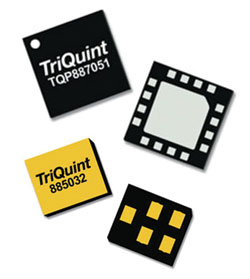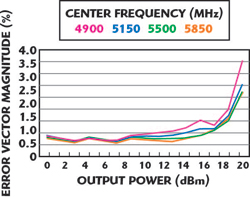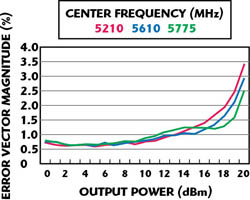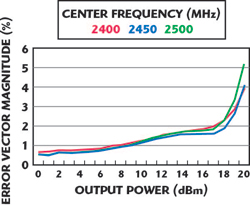
As demand for Wi-Fi increases, consumers have developed an ever-growing appetite for faster mobile data rates to support video streaming and other multimedia applications. With data rates up to 1.3 gigabits per second, the new IEEE 802.11ac standard will enable transfer rates three to four times faster than current-generation 802.11n Wi-Fi.
TriQuint Semiconductor introduced its first 802.11ac ready module for mobile devices last year. The dual-band product has been selected by a major manufacturer for its next-generation smartphone and is included on a reference design by a leading chipset supplier.
Now, TriQuint is enabling next-generation 802.11ac Wi-Fi with the introduction of three new high-performance WLAN front-end modules and two advanced Wi-Fi/4G coexistence filters. The company has captured smartphone design wins with its two 5 GHz 802.11ac Wi-Fi RF modules, as well as its new 2.4 GHz product. Thanks to advances in output power technology, all three TriConnect™ Wi-Fi modules provide extended operating ranges when compared with earlier products. For Wi-Fi users, that means the freedom of wireless connectivity across longer distances.

Figure 2 TQP887052 802.11ac performance (MCS9/VHT80-DEVM).

Figure 1 TQP887051 802.11ac performance (MCS9/VHT80-DEVM).
The TQP887051 is a 5 GHz WLAN PA and low noise amplifier with a bypass mode plus an SP2T switch MMIC and directional detector. It covers 802.11a, n and ac applications and is packaged in a module that is 2.5 × 2.5 × 0.4 mm in size. Figure 1 shows the EVM performance of the TQP887051. The TQP887052 is also a 5 GHz WLAN PA and SP2T switch MMIC packaged in a 2.5 × 2.5 × 0.4 mm module covering 802.11a, n and ac applications. Figure 2 shows the EVM performance of this module. The TQF9046 is a 2.4 GHz WLAN PA and low noise amplifier with a bypass mode plus an SP3T switch MMIC for a Bluetooth® Path and directional detector. It covers 802.11b, g and n applications and is packaged in a module that is 2.5 × 2.5 × 0.4 mm in size. Figure 3 shows the EVM performance of this module.

Figure 3 TQF9046 802.11n performance (MCS7/HT20-DEVM).
In addition to power amplifier modules that enable faster speeds, demand is surging for high-performance Wi-Fi/LTE coexistence filters. Today’s high-end smartphones contain a growing number of cellular and Wi-Fi bands to support 2G/3G/4G voice and data services, as well as global roaming. At the same time, the global spectrum crunch is leading governments around the world to squeeze new 4G bands next to pre-existing Wi-Fi spectrum, often with minimal guard bands. Advanced filter technology is needed to mitigate the resulting interference issues.
TriQuint is expanding its WLAN product line with two new specialty 4G/Wi-Fi coexistence filters. These high-performance filters serve as electronic traffic guards to keep signals in the crowded 2.4 GHz spectrum isolated from one another. They leverage TriQuint’s advanced bulk acoustic wave (BAW) technology to address some of the industry’s toughest filtering challenges.
The 885032 is an LTE/Wi-Fi coexistence filter with bands 7/41 rejection and low loss. It covers 2.4 GHz WLAN application and is 1.4 × 1.2 × 0.5 mm in size. The 885033 is an LTE/Wi-Fi coexistence filter with bands 38/40 rejection and low loss. It covers 2.4 GHz WLAN applications and is 1.4 × 1.2 × 0.5 mm in size. Both products address coexistence issues for bands 38/40/7/41; however, the 885032 is optimized to provide the best performance for bands 7/41 while the 885033 is optimized for bands 38/40.
TriQuint’s broad portfolio of WLAN modules and coexistence filters are designed to meet the most challenging needs of mobile device manufacturers today. Leveraging both its MMIC and BAW filter expertise allows it to control the complete design and manufacturing process to deliver high-performance solutions.
TriQuint Semiconductor,
Hillsboro, OR,
Info-mobiledevices@tqs.com,
www.triquint.com
